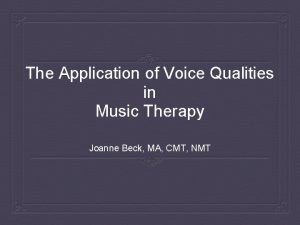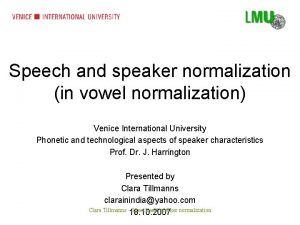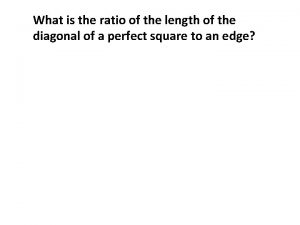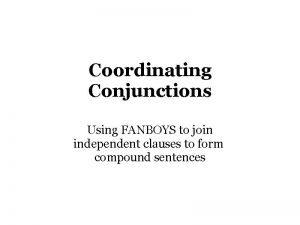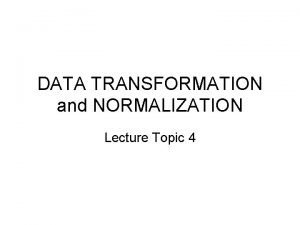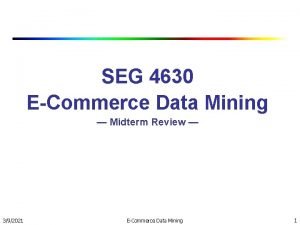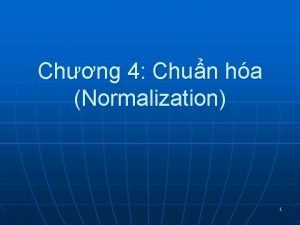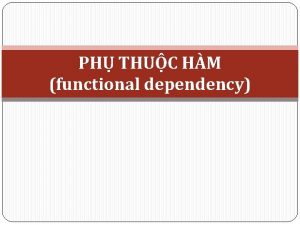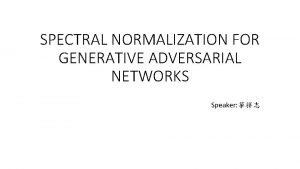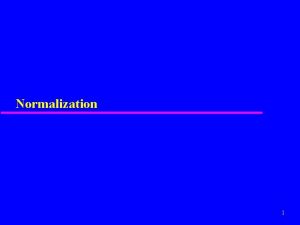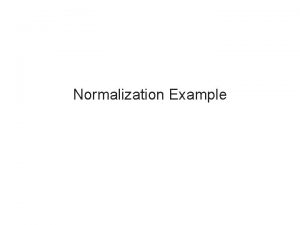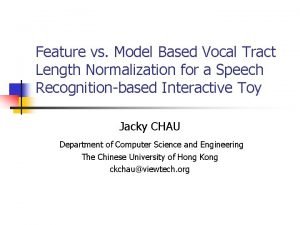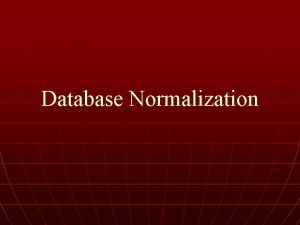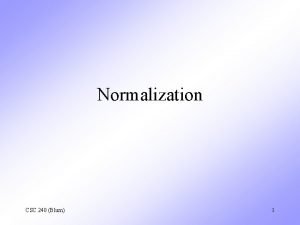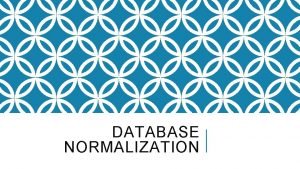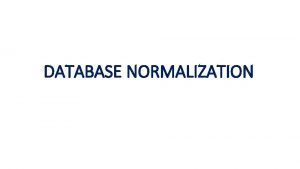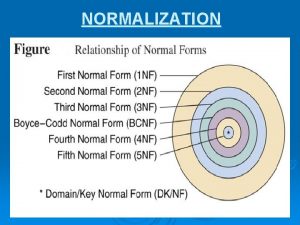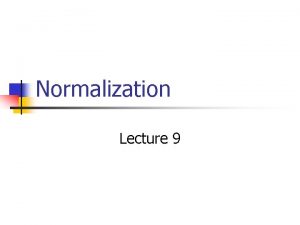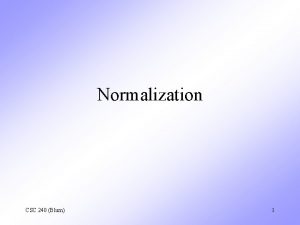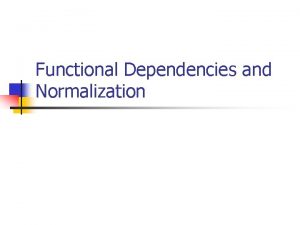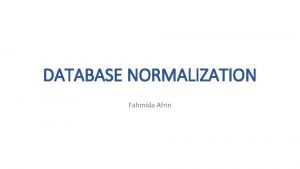Vocal tract length normalization for speaker independent acoustictoarticulatory













- Slides: 13

Vocal tract length normalization for speaker independent acoustic-to-articulatory speech inversion Ganesh Sivaraman 1, Vikramjit Mitra 2, Hosung Nam 3, Mark Tiede 4, Carol Espy-Wilson 1 1 University of Maryland College Park, MD, 2 SRI International, Menlo Park, CA, 3 Department of English Language and Literature, Korea University, Seoul, South Korea, 4 Haskins Laboratories, New Haven, CT 6/4/2021 1

Overview • Acoustic to Articulatory Speech Inversion • Motivation • Speech inversion system • Dataset used for this work • Speaker acoustic spaces • Vocal tract length normalization • Speaker transformation of training dataset • Experiments • Results • Conclusions 6/4/2021 2

Acoustic to Articulatory Speech Inversion • Challenges • Highly nonlinear and somewhat non-unique mapping from acoustics to articulations (ref) • Different possible representations of articulatory data • Approaches • Codebook based approaches (Schroeter and Sondhi, (1994)) • Gaussian Mixture Models (GMM) and Hidden Markov Models (HMMs) (Toda et al. , (2004)) • Artificial Neural Networks (ANN) (Mitra, (2010)) 6/4/2021 3

Motivation • Speech inversion systems perform really well in Speaker dependent scenario • However, cross speaker performance is very poor compared to speaker dependent performances Spkr 1 (M) Spkr 2 (F) Spkr 3 (M) Spkr 4 (F) Spkr 5 (F) Spkr 6 (F) Spkr 7 (M) Spkr 8 (M) Spkr 9 (F) Spkr 10 (M) Spkr 1 (M) 0. 80 0. 52 0. 62 0. 47 0. 36 0. 30 0. 52 0. 58 0. 52 0. 56 Spkr 2 (F) 0. 53 0. 78 0. 50 0. 61 0. 56 0. 49 0. 33 0. 41 0. 60 0. 47 Spkr 3 (M) 0. 62 0. 51 0. 75 0. 44 0. 29 0. 24 0. 53 0. 58 0. 50 0. 61 Spkr 4 (F) 0. 55 0. 59 0. 47 0. 80 0. 56 0. 31 0. 39 0. 57 0. 41 Spkr 5 (F) 0. 44 0. 55 0. 29 0. 59 0. 74 0. 64 0. 13 0. 17 0. 50 0. 34 Spkr 6 (F) 0. 30 0. 44 0. 17 0. 51 0. 54 0. 82 0. 17 0. 15 0. 35 0. 18 Spkr 7 (M) 0. 53 0. 38 0. 50 0. 34 0. 21 0. 20 0. 77 0. 56 0. 41 0. 49 Spkr 8 (M) 0. 58 0. 49 0. 60 0. 38 0. 23 0. 13 0. 59 0. 78 0. 52 0. 60 Spkr 9 (F) 0. 55 0. 59 0. 49 0. 61 0. 51 0. 42 0. 46 0. 74 0. 49 Spkr 10 (M) 0. 56 0. 46 0. 54 0. 40 0. 29 0. 22 0. 47 0. 54 0. 45 0. 80 6/4/2021 4

Speech inversion system Input Speech MFCC Feature extraction Contextual window of 160 ms Kalman Smoothing Tract Variables • Function mapping approach to speech inversion • Artificial neural networks (ANN) suitable for the highly non-linear and non-unique mapping from acoustics to TVs [V. Mitra et al. 2010] • Input features: Contextualized MFCCs (13 coeffs x 17 frames) • Outputs: 6 TVs (LA, LP, TBCL, TBCD, TTCL, TTCD) • Single Hidden layer networks • 100 – 500 nodes in hidden layer • Scaled conjugate gradient algorithm for training. 6/4/2021 5

Dataset used for this work • U. Wisconsin X-ray microbeam (XRMB) dataset consisting of 46 different subjects spanning 4 hours of speech and articulatory data. • The pellet trajectories from XRMB dataset are converted to 6 Tract Variables (TVs) using a geometric transformation (H. Nam et. al. , 2012) • Data from 10 speakers (5 males and 5 females) were selected for the experiments performed in this paper. 6/4/2021 6

Speaker acoustic spaces • 64 Gaussian mixtures to model each speaker’s acoustic space Speaker Sj’s acoustic data • Feature extraction 39 dimensional MFCC Unsupervised GMM training �� - Speaker �� Sj’s acoustic model Such GMM acoustic spaces are trained for each speaker in the dataset 6/4/2021 7

Vocal Tract-length normalization (VTLN) • 6/4/2021 8

Speaker transformation of training dataset 6/4/2021 9

Various speech inversion systems System ID SD Speaker dependent systems on all 10 speakers SI Data from remaining 9 speakers to match the amount of training data of target speaker SI_VTLN SD+SI_VTLN SI_alldata 6/4/2021 Description VTLN transformed Data from remaining 9 speakers to match the amount of training data of target speaker VTLN transformed Data from remaining 9 speakers + Target speaker’s data were randomly sampled to match the amount of training data of target speaker All training data from remaining 9 speakers SI_VTLN_alldata All VTLN transformed training data from remaining 9 speakers SD+SI_VTLN_alldata All VTLN transformed training data from remaining 9 speakers + training data from target speaker 10

Results The values in the table show average of the correlations of the 6 estimated TVs with actual TVs. Average amount of Speech inversion Training System data (mins) SD 5. 68 Spk a Spk b Spk c Spk d Spk e Spk f Spk g Spk h Spk i Spk j JW 12 JW 14 JW 26 JW 27 JW 31 JW 40 JW 45 JW 54 JW 59 M 0. 80 F 0. 78 M 0. 75 F 0. 80 F 0. 74 F 0. 82 M 0. 77 M 0. 78 F 0. 74 M 0. 80 0. 78 Average SI 5. 68 0. 61 0. 62 0. 58 0. 50 0. 45 0. 51 0. 57 0. 52 0. 56 0. 55 SI_VTLN 5. 68 0. 66 0. 61 0. 59 0. 69 0. 58 0. 61 0. 60 0. 64 0. 65 0. 62 SD+DI_VTLN 5. 68 0. 64 0. 66 0. 70 0. 61 0. 62 0. 64 0. 65 0. 66 0. 65 SI_alldata 51. 13 0. 71 0. 70 0. 69 0. 65 0. 60 0. 63 0. 69 0. 68 SI_VTLN_alldata SD+SI_VTLN_al ldata 51. 13 0. 74 0. 73 0. 78 0. 69 0. 70 0. 72 0. 70 0. 74 0. 72 56. 81 0. 80 0. 78 0. 77 0. 81 0. 74 0. 79 0. 76 0. 77 0. 76 0. 79 0. 78 6/4/2021 11

Conclusions • The proposed VTLN based speaker transformation provides 7% improvement in the case when the training data is limited to 5. 68 mins on an average. • Including a few utterances from target speaker’s training data improves the performance by 2% over Sys 2 which is trained on VTLN transformed data • Speaker Dependent system performance is 16% higher than Sys 2 which is trained on data from the other 9 speakers. • Adding all available data for training (~51 mins) gives a much better performance. • Adding all the training data of the target speaker, as done in the training of Sys 3_alldata provides a system that performs as well as the speaker dependent SD systems 6/4/2021 12

References • H. Nam, V. Mitra, M. Tiede, M. Hasegawa-Johnson, C. Espy-Wilson, E. Saltzman, and L. Goldstein, “A procedure for estimating gestural scores from speech acoustics. , ” J. Acoust. Soc. Am. , vol. 132, no. 6, pp. 3980– 9, Dec. 2012. • S. Omid Sadjadi, M. Slaney, and L. Heck, “MSR Identity Toolbox v 1. 0: A MATLAB Toolbox for Speaker-Recognition Research, ” Speech and Language Processing Technical Committee Newsletter, Nov-2013. • J. R. Westbury, “Microbeam Speech Production Database User’'s Handbook, ” IEEE Pers. Commun. - IEEE Pers. Commun. , 1994. 6/4/2021 13
 True vocal folds and false vocal folds
True vocal folds and false vocal folds Compare and contrast the vocal music of pakistan and israel
Compare and contrast the vocal music of pakistan and israel Speaker normalization
Speaker normalization Pyramidal vs extrapyramidal tract
Pyramidal vs extrapyramidal tract Olivospinal tract vs tectospinal tract
Olivospinal tract vs tectospinal tract What is the ratio of the length of to the length of ?
What is the ratio of the length of to the length of ? Fanboys connectors
Fanboys connectors Data transformation by normalization
Data transformation by normalization Minmax normalization
Minmax normalization Functional dependencies and normalization
Functional dependencies and normalization Functional dependencies and normalization
Functional dependencies and normalization Spectral normalization for generative adversarial networks
Spectral normalization for generative adversarial networks Purpose of normalization
Purpose of normalization Normalization process example
Normalization process example
